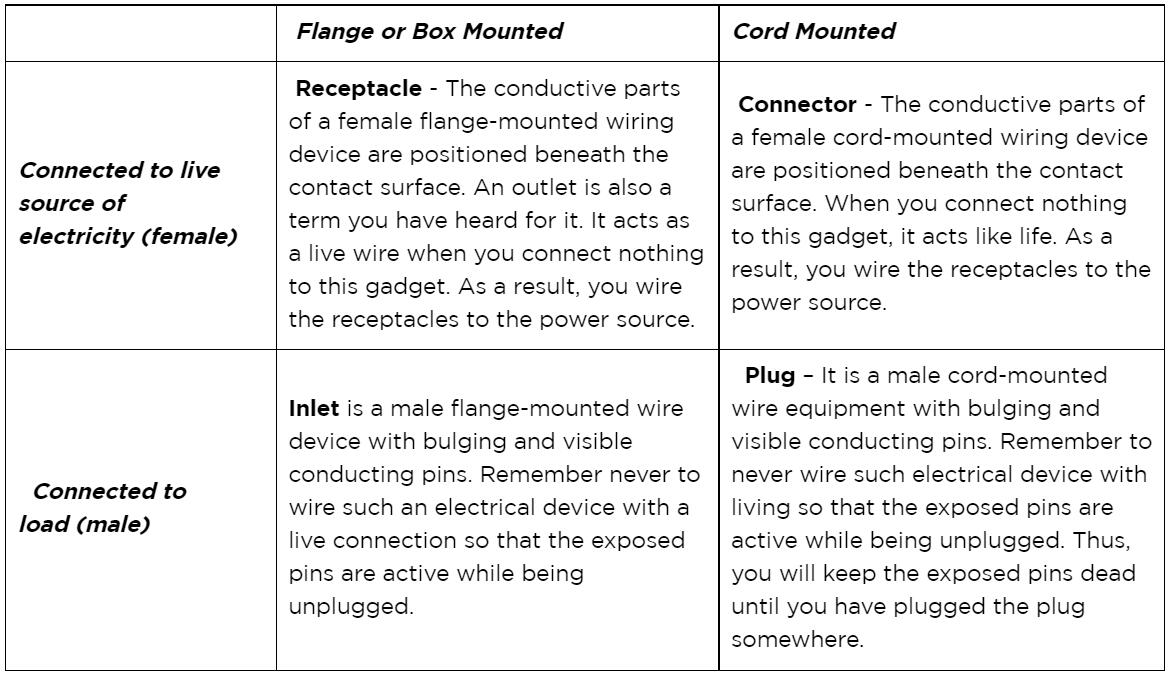The three-phase plug or simply “The Plug” is what every other appliance uses for connection. By hearing these words, your mind has clicked you with the Three-pin connector. But do you know its actual name is NEMA connectors?
NEMA connectors are the standard type of plugs that most electrical equipments use. It also comes under the name of Edison connectors. These connectors date back to 1926 when the National Electrical Manufacturers Association (NEMA) came into being. Now, let’s dig into the NEMA configuration and find the right type for your appliance.
NEMA Terminology
There are several terminologies that you might hear associated with NEMA.

What are NEMA Connectors?
NEMA Connectors, just like others from the family, connect the devices to the power sources. You can use them for Alternating current AC or Direct current DC. Moreover, you can tell the connectors from each other based on different ratings.
The US rating ranges are 15-60A and 125-600V. Connectors, outlets, inlets, and plugs are available in various blade sizes, shapes, locations, and dimensions. Moreover, connectors are non-interchangeable because of their varied size and voltage, current, and grounding capacities.
Additionally, all the manufacturers across the United States follow NEMA standards to ensure industry-wide consistency. You can use amperage and voltage to identify the pin positions of plugs and outlets.
NEMA Configurations
You can divide the connectors into two categories, Locking and Non-Locking.
The locking design has round prongs that you can twist and fix into a place. At the same time, the non-locking designed connectors have straight pins to plug and unplug into a receptacle easily.
Non-locking plugs are present on appliances where you don’t want to fix the device with the outlet. The locking plugs are preferable in applications where you don’t want to disconnect the device accidentally.
For Non-locking plugs, there is a range of connectors available, from NEMA 1 to NEMA 24. As for the Locking plugs, the types available are from NEMA L1 to L23.
Every type has its design, like the two-prong design of NEMA 1 and its Voltage rating. Moreover, some have become obsolete ultimately.

Caption: Non-locking NEMA plug chart

Caption: locking NEMA receptacle chart
NEMA Number Explaining
As for the numbering system of NEMA connectors, there is specific terminology that the manufacturers follow. Also, if you are a user and want to determine the code for your device, you can follow this table.
Things to Consider When Buying NEMA Connector
Now, buying a connector is somewhat tricky. Based on your application types, many factors need to be considered. Here are the essential points you have to keep in mind.
NEMA Connectors: Voltage
Companies offer a plug or a connector that can work with a voltage of both 110-120 or 220-240V. In the United States, you’re more likely to see 110V flat plugs and 120V flat blades with an extra round grounding pin.
Other than that, 220-240V round connectors are a popular choice. While you can use 110-120V plugs to fix extensions, pigtail connections, and everyday appliances, 240V plugs are better for industrial applications, generators, and other things that need power.
NEMA Connectors: Amperage & Wattage
If you choose a new connector, you should check for the exact amperage (amp) rating of the one you are changing. In other words, how many current ratings something uses when you plug it in is directly related to how many amps the switch has. However, if you want to figure out how many watts your plug and outlet can handle, increase the ampere rating by the volts.
NEMA Connectors: Housing
ItIt’smportant to pay attention to the housing when choosing a new plug or connector. It protects the wires and cables that go through it.
Moreover, the housing keeps the plug or connector safe from the weather. Many companies make poly butyl (butyl rubber), plastic, metal, and PVC housings.
Poly butyl housing is long-lasting, stable, and usually present in pigtails. Also, the plastic housing is a good option because it is cheaper, lighter, and less likely to break. The metal housing is long-lasting; however, PVC housing is lightweight and has enough strength to keep electronic devices safe.
NEMA Connectors: The number of Blades
Pins or blades are present on the male contact through which you can connect the plug to the female socket. Hence, you need to check the outlet so that you don’t buy an incompetent plug for the socket.
Moreover, the pins present on the plug depending on the application type. Thus, do not remove the curved grounding blades from the plug, or you might face serious safety hazards.
Caption: L21-30 plug
NEMA Power Cords
They are made to fulfill various volt and amperage criteria.
Moreover, you can use a cord to transfer power from one gadget to another.
To protect the copper conductive material, manufacturers encase it in insulation material. Almost all power cords have three parts. Specific power cords contain a locking system to avoid accidental separation.
A power cord influences how much power it might transport.
Moreover, the cord’s wiring, the number of thin conductor strands, and its length determine its amperage rating. Amperage decreases when a line contains three wire strands of conductor or is over fifty feet.
We use the American Wire Gauge (AWG) numbering system to determine the wire gauge rating. The thicker the wire, the lesser the AWG number. For instance, a 12 AWG cord has 12 G wire and works with 120V power outlets.
Caption: NEMA 5-15P with wires
IEC vs. NEMA
With the advent of electronics, there was a need for specific standards that companies could follow. So, in 1906, IEC was made, followed by NEMA in 1926. However, IEC is applicable across the globe, whereas the rules of NEMA are exclusively for North America and on the eastern side of South America.
The few differences between the IEC and NEMA are as follows.
- NEMA only needs the value of voltage and horsepower of the application. However, IEC needs much deeper details.
- The products on NEMA standards are widely applicable, whereas IEC products need a strict environment to work.
- NEMA, however, requires additional safety covers, whereas IEC products are finger-safe.
- NEMA is better at tolerating Short circuits. However, IEC is good at working in overloading conditions.
- In the end, there are no certification standards for the NEMA products. But, the IEC strictly conforms to the electrical rules.
Caption: NEMA 5-15 and IEC C13
Conclusion
NEMA connectors are found on most of the devices. There are many types available in the market with different ratings. Thus, if you want to choose the right style, you should look into the voltage and ampere it can support, the insulating material it has, and the number of blades on it. Your connection is made with attention to detail. Here at Bloom, we offer cable assemblies, and wiring harnesses with high-quality connectors.
